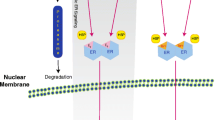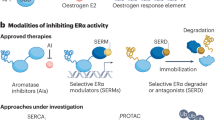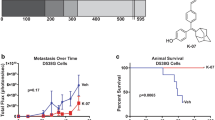Summary
Though the antiestrogen tamoxifen prolongs disease-free and overall survival in the adjuvant setting, and induces remissions in over half of the patients with estrogen receptor positive metastatic disease, all patients eventually acquire tamoxifen resistance. Furthermore, many of the resistant tumors actually appear to bestimulated by tamoxifen just as they are by estrogens. In both animal models and clinical specimens, we have found lower tamoxifen uptake and somewhat altered tamoxifen metabolism in resistant tumors, but neither appears to explain tamoxifen stimulation of the resistant tumors. Nor do estrogen receptor losses or mutations appear to explain this phenomenon, although altered expression of transcriptional variant forms of the receptor may well contribute. Pure steroidal antiestrogens such as ICI 182,780 are capable of reversing tamoxifen-stimulated as well as estrogen-stimulated growth of these resistant tumors, and are now in clinical trials for this purpose.
Similar content being viewed by others
References
Early Breast Cancer Trialists Collaborative Group: Systemic treatment of early breast cancer by hormonal, systemic or immune therapy: 133 randomized trials involving 31,000 recurrences and 24,000 deaths among 75,000 women. Lancet 339:1–14, 71–85, 1992
Saez RA, Osborne CK: Hormonal treatment of advanced breast cancer. In: Kennedy BJ (ed) Current Clinical Oncology. Alan R Liss Inc, New York, 1989, pp 163–172
Fujimoto N, Katzenellenbogen BS: Alteration in the agonist/antagonist balance of antiestrogens by activation of protein kinase A signaling pathways in breast cancer cells: Antiestrogen-selectivity and promoter-dependence. Mol Endocrinol, in press, 1993.
Encarnación CA, Ciocca DR, McGuire WL, Clark GM, Fuqua SAW, Osborne CK: Measurement of steroid hormone receptors in breast cancer patients on tamoxifen. Breast Cancer Res Treat 26:237–246, 1993
Pritchard KI, Thomson DB, Myers RE, Sutherland JA, Mobbs BG, Meaken JW: Tamoxifen therapy in premenopausal patients with metastatic breast cancer. Cancer Treat Rep 64:787–796, 1980
Hoogstraten B, Gad-el-Mawla N, Maloney TR, Fletcher WS, Vaughn CB, Tranum BL, Athens JW, Costanzi JJ, Foulkes M: Combined modality therapy for first recurrence of breast cancer. A Southwest Oncology Group study. Cancer 54:2248–2256, 1984
Osborne CK, Coronado EB, Robinson JP: Human breast cancer in the athymic nude mouse: Cytostatic effects of long-term antiestrogen therapy. Eur J Cancer Clin Oncol 23:1189–1196, 1987
Osborne CK, Coronado E, Allred DC, Wiebe V, DeGregorio M: Acquired tamoxifen resistance: Correlation with reduced tumor levels of tamoxifen and isomerization of trans-4-hydroxytamoxifen. J Natl Cancer Inst 83:1477–1482, 1991
Gottardis MM, Jordan VC: Development of tamoxifenstimulated growth of MCF-7 tumors in athymic mice after long-term antiestrogen administration. Cancer Res 48:5183–5187, 1988
Wiebe VJ, Osborne CK, McGuire WL, DeGregorio MW: Identification of estrogenic tamoxifen metabolite(s) in tamoxifen-resistant human breast tumors. J Clin Oncol 10:990–994, 1992
Wakeling AE: Steroidal pure antiestrogens.In: Lippman M, Dickson R (eds) Regulatory Mechanisms in Breast Cancer. Kluwer, Boston, 1991, pp 239–257
Parker MG: Action of “pure” antiestrogens in inhibiting estrogen receptor action. Breast Cancer Res Treat 26:131–137, 1993
Osborne CK, Jarman M, McCague R, Coronado EB, DeGregorio MW, Hilsenbeck SG, Wakeling AE: The importance of tamoxifen metabolism in tamoxifenstimulated breast tumor growth. Cancer Chemother Pharmacol, in press
Osborne CK, Wiebe VJ, McGuire WL, Ciocca DR, DeGregorio MW: Tamoxifen and the isomers of 4-hydroxytamoxifen in tamoxifen-resistant tumors from breast cancer patients. J Clin Oncol 10:304–310, 1992
Dowsett M, Johnston SRD, Haynes BP, Sacks NPM, Caum MB, Ebbs SR, Smith IE: Impaired intra-tumoral uptake as a mechanism for resistance in human breast cancer. Proc Am Assoc Cancer Res 34:1463 (Abstract), 1993
Fuqua SAW, Fitzgerald SD, Chamness GC, Tandon AK, McDonnell DP, Nawaz Z, O'Malley BW, McGuire WL: Variant human breast tumor estrogen receptor with constitutive transcriptional activity. Cancer Res 51:104–109, 1991
Fuqua SAW, Fitzgerald SD, Allred DC, Elledge RM, Nawaz Z, McDonnell DP, O'Malley BW, Greene GL, McGuire WL: Inhibition of estrogen receptor action by a naturally occurring variant in human breast tumors. Cancer Res 52:483–486, 1992
Author information
Authors and Affiliations
Rights and permissions
About this article
Cite this article
Osborne, C.K., Fuqua, S.A.W. Mechanisms of tamoxifen resistance. Breast Cancer Res Tr 32, 49–55 (1994). https://doi.org/10.1007/BF00666205
Issue Date:
DOI: https://doi.org/10.1007/BF00666205




